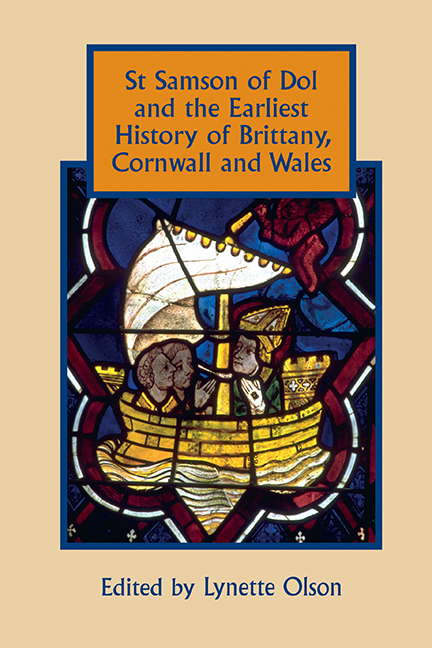Book contents
- Frontmatter
- Contents
- List of Tables
- Editor's Preface
- Map: Places associated with St Samson in the First Life
- 1 Introduction: ‘Getting Somewhere’ with the First Life of St Samson of Dol
- 2 A Family and its Saint in the Vita Prima Samsonis
- 3 La Circulation de l'information dans la Vie ancienne de s. Samson de Dol et la question de sa datation
- 4 The Hare and the Tortoise? Vita Prima Sancti Samsonis, Vita Paterni, and Merovingian Hagiography
- 5 Columbanus, the Britons, and the Merovingian Church
- 6 Apostolic Authority and Celtic Liturgies: from the Vita Samsonis to the Ratio de cursus
- 7 The Representation of Early British Monasticism and Peregrinatio in Vita Prima S. Samsonis
- 8 Present and Yet Absent: the Cult of St Samson of Dol in Wales
- Bibliography
- Index
- Studies in Celtic History
1 - Introduction: ‘Getting Somewhere’ with the First Life of St Samson of Dol
Published online by Cambridge University Press: 05 July 2018
- Frontmatter
- Contents
- List of Tables
- Editor's Preface
- Map: Places associated with St Samson in the First Life
- 1 Introduction: ‘Getting Somewhere’ with the First Life of St Samson of Dol
- 2 A Family and its Saint in the Vita Prima Samsonis
- 3 La Circulation de l'information dans la Vie ancienne de s. Samson de Dol et la question de sa datation
- 4 The Hare and the Tortoise? Vita Prima Sancti Samsonis, Vita Paterni, and Merovingian Hagiography
- 5 Columbanus, the Britons, and the Merovingian Church
- 6 Apostolic Authority and Celtic Liturgies: from the Vita Samsonis to the Ratio de cursus
- 7 The Representation of Early British Monasticism and Peregrinatio in Vita Prima S. Samsonis
- 8 Present and Yet Absent: the Cult of St Samson of Dol in Wales
- Bibliography
- Index
- Studies in Celtic History
Summary
The First Life of St Samson of Dol is a very important source for the earliest history of Brittany, Cornwall, and Wales. It has geographical breadth. According to the Life, Samson travelled. It takes us to various parts of south Wales, to Ireland and back, across Cornwall, to Brittany and beyond, visiting a Merovingian court, the mouth of the River Seine, and the Channel Islands. The author of the Life has also travelled, having been in Cornwall and south Wales, according to several first-person statements, as well as Brittany. Travel back from the Continent at an intermediate stage is indicated by what the author says about a written source encountered in Cornwall, of which much more below. The Life also has chronological depth, relating to three temporal layers: the time of the saintly subject, of the intermediate written source, and of the author of the Life. The earliest history of Brittany, Cornwall, and Wales is not well served by textual sources. Yet this is the period that saw the establishment of the Church and the spread of the monastic movement in these regions. The First Life of St Samson of Dol is the most promising additional source of meaningful evidence about these processes. It is especially informative about Wales and Cornwall, and is in itself a valuable cultural product of Brittany and testimony to the links between these regions.
Yet there are problems with the First Life of St Samson of Dol that have tended to vitiate the usefulness of this source, and the need to address these is what has given rise to this book. The main one is the date. While Patrick's writings may be said to fit most comfortably in the fifth century, and Gildas’ in the sixth, the dating of the Life has ranged over two and a half centuries, after 600 and before 850. What its author says about the sources of the Life, in a genre that is notorious for claiming evidence from good sources and delivering anything but, is anyway questionable. Also puzzling is the very large proportion of the Life that concerns Britain in comparison to what it says about Brittany, and especially Dol. Finally, the Life needs contextualisation.
- Type
- Chapter
- Information
- Publisher: Boydell & BrewerPrint publication year: 2018
- 1
- Cited by

